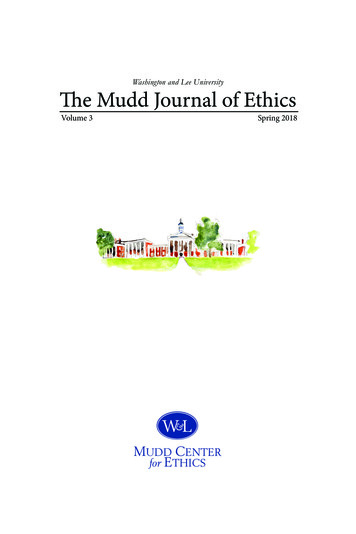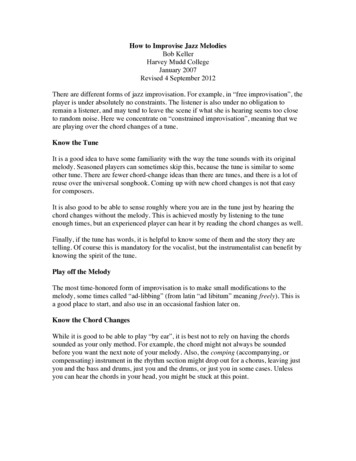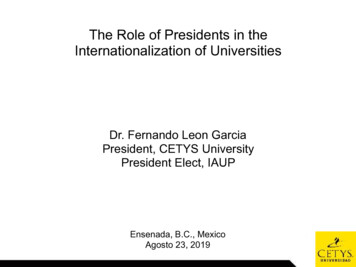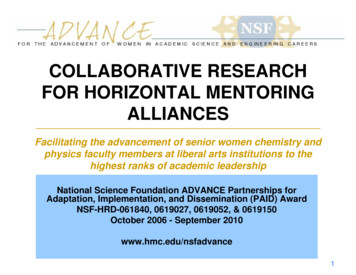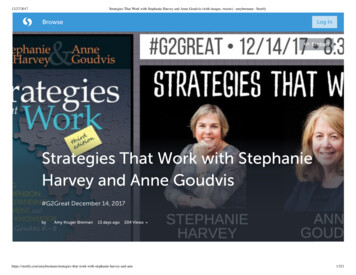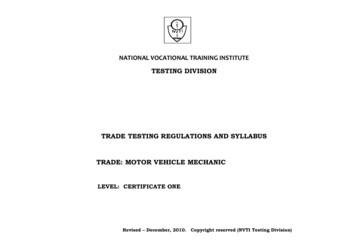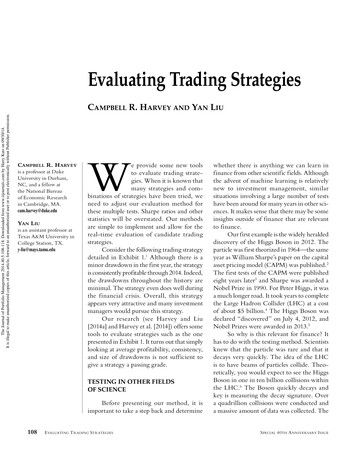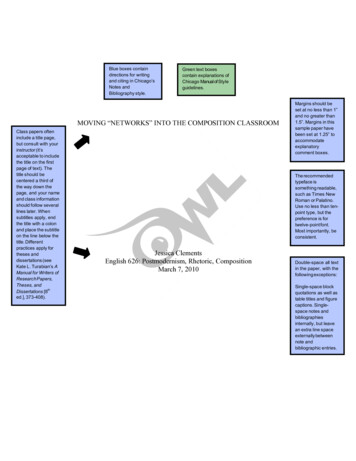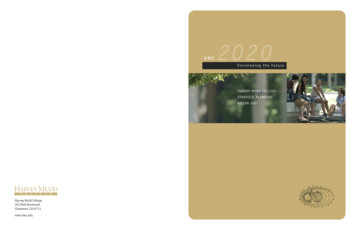
Transcription
HMCEnvisioning the FutureHARVEY MUDD COLLEGESTRATEGIC PLANNINGVISION 2007Harvey Mudd College301 Platt BoulevardClaremont, CA 91711www.hmc.edu
A Message from the PresidentThe Harvey Mudd College Strategic Vision features six themes designed to meet theI am delighted to present the new Strategic Vision for Harvey MuddCollege. In our own inimitable way, the HMC community has cometogether to examine all that we do in view of the challenges and changes inthe world today. We are committed to maintaining our role as an educationalinnovator, our intimate, supportive and rigorous learning community, andour dedication to excellence. I want to particularly thank the many students,faculty, staff, alumni, trustees, parents and others who have contributed tothe creation of this vision. We will be seeking further guidance and supportfrom you as we focus our efforts on developing and implementing theconcrete plans that will make these visions a reality.maria klawe@hmc.eduneeds of our students, our local community and the world at large.Executive SummaryHarvey Mudd College opened its doors five years after the firsthydrogen bomb test and just before the Sputnik I launch. At thistime, many were wondering if technology was being pursued forits own sake rather than to improve the human condition. Inresponse to these concerns, HMC made the commitment toeducate a new generation of engineers, scientists and mathematicianswho understood the impact of their work on society.The problems facing the world today are more challengingand more complex: global warming and the related issues ofsustainability and energy sources, the AIDS pandemic, globalization, and the social and environmental issues it engenders.HMC is poised to bring the focus and excellence it has come tobe known for over the last half century to bear on the problemsof this new century.In order to maintain our leadership as an innovative educational institution, we began a strategic planning processfor Harvey Mudd College last June. After countless hoursof discussions by representatives from all of the college’sconstituencies, we have reached consensus around a strategicvision that will build on our successes, strengths and core valuesas a unique college providing a rigorous education acrossengineering, science and mathematics with a strong emphasis onthe humanities and social sciences.The Harvey Mudd College Strategic Vision featuressix themes designed to meet the needs of our students, ourlocal community and the world at large. The six themes of thevision are:I. Innovation, leadership and impact, especially inengineering, science and mathematicsII. Experiential and interdisciplinary learningIII. Unsurpassed excellence and diversity at all levelsIV. Nurturing and developing the whole personV. Global engagement and informed contributionsto societyVI. Infrastructure and resources to support ourcommitment to excellence and building communityThis document describes how each theme relates to the HMChistory and current experience and elaborates on how, throughfocusing on these six themes, we can achieve even greater successand meet the needs of the world tomorrow.Our education will continue to include a strong emphasis onhumanities and social sciences as well as an increased emphasis oninterdisciplinary and experiential learning, so that our graduatesare prepared to become leaders in their fields and to address majorchallenges facing the world. We will continue to expand ourinfluence from regional to national to international. We willstrongly value and support our alumni who apply their HMCeducation to contribute to society in any field or endeavor. Wewill expand our influence on society beyond the contributionsof our graduates by broadly disseminating our knowledge andexpertise in outstanding education.While we will continue our deep, broad and rigorouseducation to exceptionally talented students, and to stress thattechnology should be developed with an understanding of thesocietal context, there will be changes. Our emphasis willincrease in a number of areas, including diversity, flexibility,work-life balance, international experience, infrastructureand educational innovations. We have committed ourselves toambitious objectives which we feel have compelling value. HMCis at a critical point. Many of the innovations we have introducedhave been emulated by other institutions. Unless we continue toinnovate to respond to the changing needs of the world, ouruniqueness and role as an educational leader will diminish.Today’s challenges are real and difficult, but the HMCcommunity is dedicated to surmounting them and continuing tomake our small, young, exciting and innovative undergraduateinstitution the best place in the world for a rigorous and intimateundergraduate education emphasizing engineering, scienceand mathematics.HMC 2020: Envisioning the Future1
IntroductionIn the middle of the 20th century, the United States neededbrilliant and rigorously trained engineers, scientists and mathematicians who had a breadth of knowledge across these fields, whohad a strong background in the humanities and social sciences, andwho understood the impact of their work on society. Harvey MuddCollege answered that call when it opened its doors in 1957, lessthan a month before Sputnik I launched the Space Age. Forty-eightstudents and seven faculty members constituted the pioneers whoshaped this unique institution born of the generosity of miningengineer, entrepreneur and philanthropist Harvey Mudd, and thevision of Joseph B. Platt, nuclear physicist and first president of thecollege. The founders of HMC envisioned a distinctive coeducational experience for the college’s students. The curriculum wasdesigned to create excellent scientists and engineers with unusualbreadth in their technical education accompanied by a firmgrounding in the humanities and social sciences.Another important distinction was the teaching model: classsizes were small, and the interaction between students and facultymembers was high; academic programs were demanding, but thecollege fostered cooperation rather than competition through astudent-directed honor code. The college benefited greatly frombeing a member of The Claremont Colleges (PomonaCollege, Claremont Graduate University, Scripps College,Claremont McKenna College, HMC, Pitzer College, and KeckGraduate Institute of Applied Life Sciences), with access toexcellent library and student services, as well as the courses andfaculty at the other colleges. All of these attributes are still at theheart of an HMC education. To capture a sense of the college’smission and purpose, President Platt drafted a mission statementin 1956 that continues to guide the college: Harvey MuddCollege seeks to educate engineers, scientists and mathematicians well versed in all of these areas and in thehumanities and social sciences so that they may assumeleadership in their fields with a clear understanding of theimpact of their work on society.Today, HMC is a small residential college, with roughly 730students and 80 faculty, that is widely recognized for its programmatic innovation, excellence and rigor. U.S. News & World Reportconsistently ranks HMC among the top 20 undergraduate liberalarts colleges; we were tied for 14th in 2006. The college has receivedmany other honors within the last year, including being tied for first2HMC 2020: Envisioning the Futureplace in undergraduate engineering programs among U.S. nondoctoral institutions (2007 U.S. News & World Report, “America’sBest Colleges”), being named one of the 25 “New Ivies” (2007Kaplan/Newsweek), receiving the inaugural award for exemplaryprogram or achievement by a mathematics department (AmericanMathematical Society), and having one of the best engineeringdesign programs in the United States (2006 BusinessWeek).Harvey Mudd College has one of the highest percentagesof graduates who go on to earn Ph.D.s. In a 2002 ResearchCorporation study, we were ranked first in the number of sciencegraduates earning a Ph.D. in the natural sciences within six yearsof graduation. The college’s reputation is built upon the excellenceof its faculty and students, its independent spirit and sense of fun,the quality and innovation of its programs, and the extraordinarycaliber and achievements of its graduates.Planning for the future of Harvey Mudd College must takeinto account our role within the Consortium. As a group of sevenoutstanding educational institutions (five undergraduate and twograduate), with a unique level of shared resources, there are manyopportunities for greater collaboration on both new and existinginitiatives. In all six areas of our Strategic Vision, we will beseeking to strengthen our collaborations within the Consortiumto better leverage and contribute to our shared resources.The Strategic Planning ProcessPreliminary work on HMC’s Strategic Plan began with focusgroups for parents, alumni, industry representatives and theon-campus community, and with a request to members of theHMC community to suggest possible topics for strategic planning workshops. The strategic planning steering committee,chaired by President Klawe and composed of trustees, faculty,staff, students and alumni, chose themes for four one-dayworkshops that were held during fall 2006: Responding to aChanging World; Maximizing Our Impact on Society;Optimizing the HMC Experience; and Looking Outside the Box.Planning committees, made up of members from each of thecollege’s constituencies were formed for each workshop, withco-chairs selected from members of the steering committee. Eachplanning committee selected up to nine specific discussiontopics within the main theme.The week of Oct. 16, 2006 was set aside for the importanttask of institutional reflection. HMC classes were cancelled toallow faculty and students to participate fully and to hear theinvited speakers who launched each workshop with inspiring talksrelated to innovation, global economics, diversity, education,collaboration and science, technology, engineering andmathematics (STEM) trends (video archives are available atwww.hmc.edu, under “Office of the President”). Over four days,more than 400 people including trustees, students, alumni, staff,faculty, parents and other individuals listened to each others’ ideas,commented, reflected and made recommendations relating to thetopics. The planning committees then summarized the discussionsand distilled them further for another round of workshops heldduring the annual retreat of the HMC Board of Trustees.At that retreat, 110 participants — including trustees, alumni,faculty, students and staff — discussed 23 topics over the two daysof workshops. The steering committee went to work again after thatbusy weekend to prepare the first draft outline of the strategic vision.The outline was presented to the HMC community several timesbetween Nov. 16 and Dec. 9, and revisions were made in responseto the feedback received. The six themes of the Strategic Vision arepresented here.Strategic PlanningOver four days, more than 400 people including trustees,students, alumni, staff, faculty, parents and other individualslistened to each others’ ideas, commented, reflected andmade recommendations relating to the topics.HMC 2020: Envisioning the Future3
Strategic Vision Theme I Innovation, Leadership and ImpactI.Dan Strenge ’06 and Stephanie Feldman ’06examine a frog embryo with the OCM.Innovation, Leadership and Impact, Especially in Engineering, Science and MathematicsThe United States has distinguished itself with revolutionaryadvances, particularly in engineering, science and mathematics.More than two centuries of creative thinking and innovativedesign have resulted in achievements that have transformed theway people live and work — from the cotton gin and magneticresonance imaging, to the Internet. The U.S. has usually beenresponsible for the research and development of “the next bigthing” while the rest of the world has followed its lead. Thisjourney has brought this nation to the forefront of economic andsocial prosperity while also benefiting the economies andtechnological infrastructures of many other nations.In a speech given on the HMC campus in 2006, NationalScience Foundation Director Arden Bement Jr. remarked thatinnovation today is not limited to one scientist or one nation.Instead, it is increasingly the result of connections that crisscrossthe globe. He said, “We can count on the solid foundations ofour academic institutions, but we can no longer get by with narrowcurriculum, static teaching techniques or teaching which doesnot inspire or motivate.” The nations that pull ahead are thosethat quickly embrace new knowledge regardless of its source andpropel its citizens along new economic and technological pathways.Higher education in the U.S., then, needs to prepare for thedemands of global citizenship, and HMC is well-positioned tobe a leader. Our significant requirements in the humanities andsocial sciences, our Integrative Experience courses, our traditionof experiential learning and real-world projects, and our growingprovision of opportunities for research and study abroad, set atrend that will gain importance as the U.S. prepares its studentsfor this future.Our commitment to undergraduate learning allows andmotivates continued pedagogical innovation. Faculty membersemphasize active learning through small-group seminars, studentled team projects and independent study. Students are engagedwith faculty in research projects at all levels with access to stateof-the-art research equipment not often found at similar-sizedinstitutions. Faculty are encouraged to do research in pedagogy aswell as their specific disciplines. Nevertheless, like all highlysuccessful institutions, HMC has developed some resistance tochange and to taking risks. To continue to be as successfullyinnovative in the future as we have been in the past will require4HMC 2020: Envisioning the Futurea new level of attention, effort and resources. We must ensurethat our curriculum, our organizational structure and ourprocesses for promotion, tenure and recognition supportinnovation and agility to move into important new areas. Wemust become more self-aware and deliberate about what we aredoing and why. We will need to study the very process ofinnovation and use what we learn to inform our own departmentsand committees. We must offer programs that teach andstimulate creativity and innovation in our students and graduates.We also need to increase the opportunities for our studentswho are interested in exploring areas such as economics, policy,education, communication and entrepreneurship, where theirtechnical expertise in the STEM fields can be of significant value.There is a great societal need for more people working in suchareas to have a strong understanding and appreciation ofengineering, science and mathematics.Given our expertise in inspirational teaching in STEM fields,and the tremendous need for such teaching in the U.S. and therest of the world, we have a responsibility to share this morebroadly. Our impact and influence can be increased by creatingprograms to host post-doctoral fellows and faculty from otherinstitutions, and by expanding the conferences we offer in STEMeducation. Likewise, many teachers in high school and earliergrades, can benefit from summer programs where our faculty andstudents engage them in learning about exciting advancesin engineering, science and mathematics, and collaborate indeveloping instructional resources appropriate for their students.Finally, we can better serve our community and ensure a pipelineof qualified applicants from less advantaged backgrounds byexpanding and integrating summer programs for high schoolstudents with unusual ability but who lack access to excellentteaching in science and mathematics.HMC has much to offer regarding innovative and effectiveeducation in the STEM fields. We need to be more proactiveabout celebrating, rewarding and sharing our achievements inthese areas.Interdisciplinary InnovationDetailed motion pictures being created inthe HMC physics lab show how frogembryos grow and change in the earlieststages of development. Using an opticalcoherence microscope (OCM), studentshave created three-dimensional pictures ofcell activity below an organism’s surfacewithout cutting or otherwise damaging theorganism. Their work, and that of theirclassmates and faculty advisers, is addingto our understanding of how cells interactas they differentiate into distinct partsof the body.The OCM project at Mudd is notedfor being highly interdisciplinary and hasinvolved students and faculty from all sixmajor programs. More than 100 studentresearchers have worked on the project, which has requireddesigning and constructing the optical coherence microscopeto study fundamental problems in developmental biology. Inaddition to the study of the frog (Xenopus laevis), the OCMis being used to study another model system, the plantArabidopsis thaliana, which has potential importance to theagricultural industry.Work began in 1996, when the OCM was acquired with aNational Science Foundation award. Andrew Schile ’01, incollaboration with Caltech professor and HMC Trustee ScottFraser ’76, produced the first time-lapse frog embryo movies byacquiring many successive 3-D images of gastrulation, at timeintervals of 10 minutes, and splicing them together. In 2004,with Burton Bettingen Professor of Physics Richard Haskell,Sean Skelly ’04 constructed an OCM operating at 1300nanometers to improve depth penetration and resolution overthe original OCM instrument that was operating at 850 nm. Afaster CPU in the new instrument allowed researchers toenhance motion-sensitive images. In particular, researchers havebeen looking at internal cellular structures, at vegetal rotationand neural fold closing, all critical events in the early development of animals. The OCM is capable of non-invasively,non-destructively imaging cells or groups of cells located up toone millimeter below the surface of living tissue, regionsrendered opaque using conventional microscopy techniques.Modern visualization software turns these OCM images intothree dimensional, time-lapse movies of tissue development, anexciting outcome for developmental biologists and for undergraduates at HMC. The OCM research project has generatednew HMC courses and course material in physics, engineeringand computer science. Also, the design of the OCM and theapplication to plants and agriculture are sufficiently unique thatthe college has applied for a patent.The Clinic TraditionHMC’s Clinic Program is a nationally recognized hallmarkof the college that engages students in the solution ofpreviously unsolved technical problems for clients inindustry, government and other institutions. Founded as aninnovation in engineering education, this program hasexpanded to other departments within the college and hasbeen emulated by institutions worldwide. More than 1,000projects have been undertaken over the 40 years since theprogram’s founding.HMC 2020: Envisioning the Future5
Strategic Vision Theme I Innovation, Leadership and ImpactII.Focus o n Experient ial and Int erdisciplinary Learningshowed the changes in vibrations during the fire. Just like a heartrate monitor, the line on the monitor began to move downwardas the fire compromised the structure. Five minutes before thecollapse of an overhang, and before weighted trash cans fellthrough the roof, sensors detected changing vibrations.The research is designed to provide firefighters with information that clearly indicates regions in a building where weakeningis taking place, and to provide indicators that describe therapidity of these changes. With this information, firefighters canproceed with informed caution and enhanced safety.Imagining MathHot ResearchAccording to the National Fire Protection Association, 968firefighters died in the line of duty in the 10-year period endingin 1999. Eighteen percent of the fatalities that occurred instructure fires were due to the collapse of the structure.Creating an early warning system for firefighters that willpredict structure collapse is one of the projects currently beingundertaken by Ziyad (“Zee”) Durón ’81, Jude and Eileen LaspaProfessor of Engineering. Durón also is director of the Frank andFrances De Pietro Fellowship in Civil Engineering, created byTrustee Robert De Pietro ’69 and his brother Dennis, which givesstudents an opportunity to participate in this research.Using the HOBS (Health of Burning Structures) system,Durón and his fire research team mounted a series of monitors onan abandoned school building in Fillmore, a rural community innorthern Los Angeles County, and gathered data as the buildingwas allowed to “free burn.” The researchers were pleased with theresults of the Fillmore burn, the 13th since Durón began theresearch in 2001. The student team observed as data from sensorsThe HMC Department of Mathematics regularly hostsmathematical activities, exploration and inquiry centered aroundan area of cutting-edge mathematics research. During a recentImagine Math Day designed for high school mathematicsteachers and students, participants explored graph theory throughvarious applications of graphs. Together they learned enoughabout graph theory to participate in the main activity of the day,that of developing and exploring different notions of graphcomplexity. Students developed posters that explained their ideasand displayed them at the end of the event. The event wasorganized by the HMC Professional Development and OutreachGroup, which has received funding from the Institute forAdvanced Study/Park City Mathematics Institute and theMellon Foundation.At Harvey Mudd College, we are not just training engineers,scientists and mathematicians who can do routine calculations.Society needs technical experts who can also be leaders,innovators and responsible decision makers.”—Daniel Goroff, vice president and dean of the faculty6HMC 2020: Envisioning the FutureThe traditional organization of learning in universities andcolleges is by separate academic disciplines, and these disciplineshave become increasingly specialized over the last century. Thetraditional ivory tower model of higher education isolatesstudents from real-world issues. On the other hand, solving anyof the important challenges facing the world requires insight andexperience from several academic disciplines and practicalknowledge.Harvey Mudd College has challenged these traditions fromits beginning. Founding President Joseph Platt, a researchphysicist, and the first faculty member, J. Arthur Campbell,a noted chemistry educator, merged their strengths to create aunique vision of learning science and engineering through theactual practice of these disciplines—that is, by conductingbasic and applied research, and working on present problems.Students with this kind of education are far better prepared tomove on to work or graduate research, having had anopportunity both to integrate their classroom knowledge andto develop specific skills and insights that will be required.The ability to conduct original investigations, to plan anapproach to a problem and to see it through, is essential tosuccess in any significant engineering, science or mathematicsendeavor.Experiential learning via Clinic projects, design courses andmodeling competitions has been a large part of an HMCeducation for several decades. More recently it is increasingly apart of other HMC courses. For example, students are teamingup with local elementary and high school students to work onprojects and to offer their technical expertise in areas includingchemistry, mathematics, engineering and computer science. Thetradition of students engaging in summer research at HMC alsodates from our founding, and participation is increasing eachyear. As part of this vision, our goal is to offer a summerresearch, Clinic, internship, or community-engagementopportunity for every student who wants one. Our offeringsmust include introductory opportunities in interdisciplinaryareas so that students can get a taste of research across a range ofdisciplines, as well as opportunities to do highly advanced work.We hope to establish a coordinating capacity to match studentswith faculty and organizations offering experiential learningopportunities, whether through course work, research ortangible projects.Although our current curriculum is divided into fourcomponents: the Common Core, the major, the programin humanities and social sciences, and the IntegrativeExperience, it remains more integrated than that at manycolleges, tied together with a strong emphasis on oral andwritten communications, the development of computationalskills, and the social context of what is being studied and whatis going on around the world. One of the four components,the Integrative Experience, is explicitly designed to connectthe upper-level technical elements of major courses withadvanced work in the humanities and social sciences. Inengineering, the required systems sequence is unique, taughtby faculty from electrical, mechanical, chemical and civilengineering disciplines, with contributions from physicsand chemistry faculty. We have established several interdisciplinary majors — currently chemistry and biology,computer science and mathematics, and mathematicalbiology — though progress is still needed in fully integratingthe learning experiences across disciplines.Our goals for the future include increasing interdisciplinary learning in the core curriculum, expanding ourinterdisciplinary majors and research projects, andestablishing centers to stimulate and support interdisciplinarylearning and research in specific areas. One possible approachis to use themes, such as life sciences, computation orsustainability, as an integrating vehicle throughout thecollege. Whatever approach is taken, achieving our goals forinterdisciplinary learning will require a commitment toeliminating the unintended barriers arising from the standarddiscipline-centric department structure.HMC 2020: Envisioning the Future7
Strategic Vision Theme II Focus on Experiential and Interdisciplinary LearningGrad school for undergradsService-learning lessonsAn extraordinary number of students — off-campus students aswell as those involved through Research Experience forUndergraduates programs in chemistry, computer science andmathematics — engage in summer research, a tradition at HMCfor 50 years. In 2006 alone, 170 students and 50 HMC facultyparticipated in what has been deemed the “grad school forundergrads.”Nearly 120 projects spanning the fields of biology, chemistry,computer science, engineering, mathematics and physics wereundertaken during the recent Summer Research Program.“Faculty members work very hard for their research fundingand they are vested in the outcomes of these projects,” saidAssociate Dean for Administration Gerald Van Hecke ’61, whooversees the college’s Summer Research program. “The facultyand students here are true collaborators.”Established in 1960 with just six chemistry students, the10-week Summer Research Program was originally funded by aNational Science Foundation grant as part of a nationwide effortto promote undergraduate research. Since then, the programand its activities have only grown larger and more interesting.“The excitement of discovery in a laboratory is a verydifferent type of discovery from learning in the classroom,” saidChemistry Professor Shenda Baker, who led a number ofsummer research projects. “The possibility of synthesizingsomething that no one else ever has, or seeing or creating astructure that no one else has made can be a very motivatingforce for students to get back into the classroom to learn moreabout why materials and chemicals behave the way they do.”Over the past few decades, a steady increase in both internaland external funding has enabled HMC’s Summer ResearchProgram to continue to grow. In addition to the many individualfaculty research grants, the Summer Research Program is alsosupported by funds to the institution from NSF, the HowardHughes Medical Institute, the HMC Arnold Beckman ResearchEndowment and the Baker Foundation, among others.To determine just how much impact local traffic has made onthe environment, HMC is offering “Service-Learning inChemistry: Lead in Soil from Vehicle Emissions,” which is beingfunded by a grant from the National Science Foundation andwith additional matching funds from the Ludwick FamilyFoundation and The Camille and Henry Dreyfus Foundation.The project contributes to the college’s goal of educatingstudents not only in the technical aspects of science andengineering, but also in the social responsibilities of scientists,and the interrelation of science and society.Under the direction of Hal Van Ryswyk, professor ofchemistry, students in the first-year chemistry laboratory plan,sample and test for lead in soils from vehicle emissionsthroughout the community. In the process, they arecollaborating with students in a probability and statisticscourse, with fifth- and sixth-graders at Vista del ValleElementary School in Claremont (whose students arepredominately from groups traditionally underrepresented inscience and technical fields), and with the CaliforniaChildhood Lead Poisoning Prevention Program.Students focus on the determination of lead in soils alongroadways, in school playgrounds and in public parks adjacent tothe major roadways bisecting Claremont. They perform theentire sample preparation in a single laboratory period usingmicrowave-assisted digestion and a fast-sequential analysisatomic absorption spectrometer.The data collected in this project is revisited by students in acore mathematics course in probability and statistics, allowingthem to undertake more sophisticated analyses. The students’data will be ultimately aggregated with that of Jonathon E.Ericson, professor o
HMC Envisioning the Future HARVEY MUDD COLLEGE STRATEGIC PLANNING VISION 2007 HarveyMuddCollege 301PlattBoulevard Claremont,CA91711 www.hmc.edu


